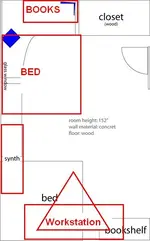A1A2
New member
Hello all,
I've recently moved back to taiwan and due to the space limitation, I am kinda stuck with one layout. My speakers are in a corner, one against a glass window, and the other one against a closet..., and therefore, giving me terrible reverb. So, I was wondering, without moving around, what can I add to help my situation. Would diffusers help? if so, what size, and where should I position them?

thanks,
Al
I've recently moved back to taiwan and due to the space limitation, I am kinda stuck with one layout. My speakers are in a corner, one against a glass window, and the other one against a closet..., and therefore, giving me terrible reverb. So, I was wondering, without moving around, what can I add to help my situation. Would diffusers help? if so, what size, and where should I position them?

thanks,
Al


